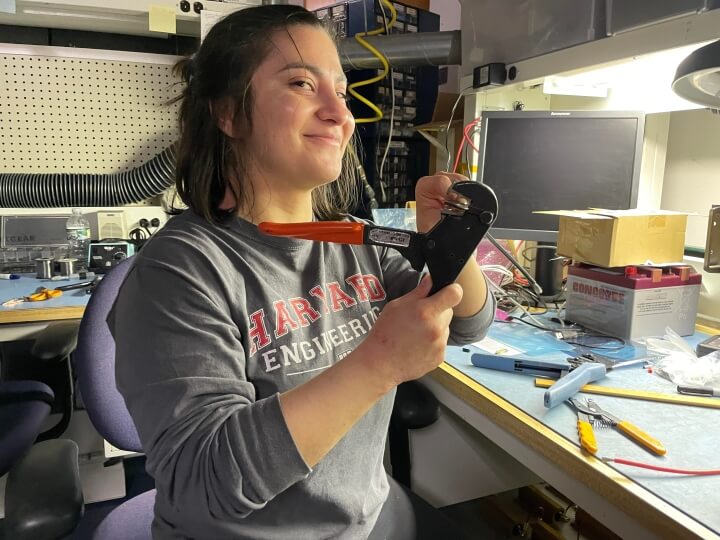For a senior capstone project, Maggie Vallejo studied how microcracks can predict power losses in solar cells.
Engineering Design Projects (ES 100), the capstone course at the Harvard John A. Paulson School of Engineering and Applied Sciences (SEAS), challenges seniors to engineer a creative solution to a real-world problem.
Using Electroluminescence Imaging to Predict Solar Cell Power Losses
Maggie Vallejo, S.B. ‘23, Environmental Science and Engineering
Advisor: Craig Mascarenhas
Please give a brief summary of your project.
My client is working on a fully autonomous solar-powered aircraft to analyze the stratosphere to combat climate change. My project aims to provide an inexpensive and rapid quality control method to sort solar cells based on power performance. I used electroluminescence (EL) imaging to detect microcracks in solar cells and wrote a computer algorithm to predict power losses based on the length and orientation of each microcrack.
How did you come up with this idea for your final project?
During the summer, I was investigating how solar cell performance was impacted by the angle of incidence and different states of mechanical failure. I met weekly with Bryan Yoon, Assistant Director of Undergraduate Studies in Environmental Science and Engineering, and Craig Mascarenhas, Fellow in Environmental Science and Engineering, to generate a problem statement based on this past research experience.
Is there a real-world challenge that this project addresses?
There have been a few recent strides to make power predictions based on a primarily qualitative technique like EL. This project tailors current research to specific solar cells used for the stratospheric aircraft.
What was the timeline of your project?
I spent most of the time defining the problem because I had no idea what I wanted to do. Designing the MATLAB algorithm also took a lot of iterations to find the order of preprocessing steps to detect microcracks. I also needed to collect a lot of data to train the algorithm to make power predictions based on EL images.
What part of the project proved the most challenging?
The MATLAB algorithm was the most challenging because I had limited coding experience and it was difficult to identify microcracks in EL images. It took a lot of time to find the right steps and thresholds that would allow me to extract microcracks in the EL images.
What part of the project did you enjoy the most?
I loved taking EL images! It was always exciting seeing internal defects that cannot be seen with the naked eye.
What did you learn, or skills did you gain, through this project?
Apart from learning about electroluminescence imaging and image processing, I learned to contact different people for help. I was surprised that the scientific community was so receptive to replying to my cold emails and sharing their expertise with me.
Press Contact
Matt Goisman | mgoisman@g.harvard.edu
